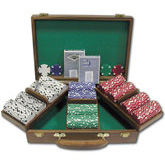Texas Hold 'em Poker - Part 2
In part one of 'Texas hold'em', we discussed the basics of poker, the winning poker hands, and the techniques behind betting and folding. Now let's get into the specifics of Texas hold'em poker.
Texas hold'em poker has rapidly become one of the most popular games in the casino. There's a great deal of skill and strategy involved in Texas hold'em, as opposed to many other poker games which can often be dismissed as [as Vesper might say,] "a game of luck". Not only is there much more action in hold'em poker, but it's also where you'll find players get deeply into bluffing, so you'll need to start working on your "poker face."
The Basics of Texas Hold'em
 Let's briefly describe a typical round of Texas hold'em, and then go back and break it down to its details. An over-simplified round would look like this:
Let's briefly describe a typical round of Texas hold'em, and then go back and break it down to its details. An over-simplified round would look like this:
At the very start of the game, the player who happens to be holding the shuffled deck may say, "High card for dealer position," and will proceed to deal out one card to each player at the table. The player who was dealt the highest card will be the first dealer. Now the game is officially underway.
Each player at the table is dealt two cards. Players then make a round of bets based on the strength of those two cards. After the first round of betting, the dealer lays out three community cards in the middle of the table. Players can now start sizing up the strength of their hands, based on the two cards in their hands, and the three community cards. Then, another round of bets takes place. Next, the dealer lays down a fourth card, followed by another round of betting. Finally, the dealer places the fifth card down on the table, and the last round of betting happens. Once the final round of betting is over, the players reveal their cards, and the player with the best hand wins.
Now let's break down each step of the game play.
Posting the Blinds
Before the cards are dealt, the initial bets are placed. We mentioned that in Texas hold'em poker, the players responsible for the initial bets are called the "blinds." The two players sitting to the left of the dealer are the "blinds." The player to the immediate left of the dealer is the "small blind," and the player two seats left of the dealer is the "big blind."
The players will have established what the limits are before the start of the game. So let's say, for example, you're playing a friendly game and the minimum bet is $10. In this case, the small blind will put up $5, which is half the minimum bet in this case. The big blind will put up $10, which is equal to a full minimum bet. Now that the blinds are up, the deal begins.
Dealing
Poker is similar to typical card games, as the responsibility of dealing the cards for each hand simply rotates clockwise around the table, rotating the blinds along with it. So in an average home game, each player will get a chance to deal the cards.
However, if you were sitting at a Texas hold'em table in a casino, you might notice a small disk sitting in front of one of the players with the word "dealer" inscribed on it, despite the fact that this player isn't dealing the cards at all. This little disk is referred to as the "button." Why do we need the button to identify the dealer position? So in a casino game, where the professional dealer deals every hand, the dealer and blind positions rotate accordingly. The players will rotate the button with each hand, and the dealer will send the first card to the player to the left of the button.
Since players will be dealing the cards in a typical, non-professional game, you probably won't see the button so much here, as it will be fairly obvious who is dealing the hand. But you'll definitely see it in the casino just so that players are absolutely positive about where the dealer position is at all times.
So we know who the dealer is and we know who the small blind and the big blind are. The bets are in, everyone's got their drinks so now it's time to deal the cards. The first two players to the left of the dealer have put down the "blind" bets, so the dealer will now begin the hand by dealing two cards face down to each player.
The player's two cards also referred to sometimes as "pocket cards." When you hear seasoned players talk about what they have in their pockets, they're talking about the two cards that they have in their hands. If you hear, "I went out with pocket jacks," it means that player folded even though he had a pair of Jacks in his hand.
The First Round of Betting
Each player looks at his or her cards, and may now increase the stakes by making bets based on the strength of those cards. The first two players to the left of the dealer have already put down their blind bets, so the player sitting to the left of the big blind is now the first one to bet, and then the betting continues clockwise around the table.
So lets say it's your turn to bet; what are your options?
You may remember that we said in Part I that you have three general options when it comes to betting: you can "call," "raise," or "check." "Checking" means that you are choosing not to make a bet. However at this stage of the game, a player may not simply "check" since blind bets have already been placed. So with existing bets on the table, you have the choice to call, putting down $10 to match the big blind bet, or you can raise with a larger bet. Or you can simply fold out of the game.
If you decide to raise, then other players have the option to match the bet, or raise it even more. If another player raises the bet even higher, then it will be up to you to match the new larger bet, or fold.
What happens when the betting reaches the blinds? The small blind, having already placed half a minimum bet before the deal, will now be responsible for the other half of the bet if he wishes to remain in the hand, along with any other raises. The big blind, having already placed a full minimum bet, now has the option to check if no other player has raised the bet, or he must match any raises to stay in the game. If no one has raised, then the big blind has the option to raise the bet, and if he checks then the round of betting has ended, and the dealer will continue with the "flop."
The Flop
The dealer now "burns" (or buries) one card, and then deals three cards in the center of the table face up. Those three cards are known as the "flop." The three cards on the table and the two cards in your hand together represent your potential hand. Of course, the three "flop" cards are community cards, so the cards on the table are also part of everyone else's hand. So be aware that those three cards on the table help everyone else too. For example, if there are two aces showing at the center of the table then you know that every other player has, at the very least, a pair of aces as well.
So now that the flop has been revealed, the next round of bets will ensue, this time starting from the player to the immediate left of the dealer (the small blind).
The Turn and The River
The next two rounds will happen much the same way. After the bets have been completed, the fourth card is going to be flipped face up (don't forget to "burn and turn") and placed in the center of the table. That fourth card is known as the "turn." Another round of betting takes place. Then the fifth card, which is known as the "river," gets flipped and placed on the table. Now that all five cards have been laid in the center of the table, the final round of betting takes place, and then it's time for the show down.
The Showdown
When all the bets have been placed and met, it's time for the players to reveal their hands. Of the players who are left standing, the players who have not folded out, the winner is the player who holds the best hand, using a combination of the five cards in the center of the table and the two cards the player has in his hand, or his "pocket cards." Whoever can make the best 5-card hand using those seven cards wins the pot.
Congratulations! You have just finished your first hand of Texas hold'em poker.
Strategies in Texas hold'em
Once you understand how to play Texas hold'em, it's time to think about some strategies involved. That's where the fun begins.
When you're a beginning player, you'll be concentrating on your hand and trying to put together the best hand you can between the two in your hand and the five on the table and you'll make bets based on the strength of the hand. A more seasoned player, however, realizes that the real game is reading the other players. Knowing what the other players are doing, and why, means everything in this game.
With that in mind, you're going to cultivate some strategies. Here are some things to consider when you're playing Texas hold'em.
Your position:
Your position at the table may give you some power, and the "late positions" have the advantage. If you are one of the blinds, just left of the dealer, you're sitting in what is known as an "early position." As you go around the table, there's a middle position, and then late positions. When you have a late position, you have an edge. If you're one of the last players to bet, you've already seen what the other players have done. You'll already have seen who's folded, who's bet, and by how much. You can start to size up who has weak hands and who has strong hands. Remember, poker is a game of information. The more information you can gather, the smarter you can play.
Your First Two Cards:
Your first two cards are critical. The two cards in your hand, or in your pocket, should be strong enough cards for you to continue. One of the keys to this game is survival. A poor player is going to want to keep playing as often as he can, staying in when he shouldn't and getting knocked out quickly.. A smart player chooses his battles wisely. So your first two cards are your first important decision. Winning a game of poker means making good decisions. If you have the beginnings of a strong hand in your first two cards, then play on.
Some players may tell you that any two cards can win. This may be true, but you want to play smart poker. Make sure your first two cards are strong ones.
There are also other facts to consider when you are deciding how strong your two pocket cards are. For example, if you have cards that can be turned into a straight or a flush, then you might want to consider playing them, but consider the gaps between the cards. For example, lets say you are dealt a Jack and a 10. There's a reason that the Jack-10 combination is slightly better than the Queen-10 combination, or the King-10 combination. All three sets can help you make a straight, but if you have the Jack-10, you have a little more flexibility in terms of which cards you would need to get the straight.
Playing the Flop
Aside from the initial dealing of the pocket cards, and your decision to stay in the game or fold, the flop is probably the most important moment in Texas hold'em. The flop will make or break your pocket cards. It might give you a really strong hand, or two strong pocket cards could now be useless because of a flop. You want to make sure that the flop fits your hand. Only two more cards will be turned over. So at this point in the game you should make sure that you have strong cards before you go farther.
Playing the Turn
The turn is where you might hear some big betting going on. This is where players might have just completed straights or flushes. If you feel that you're ahead at this point, make bets. If you're behind, fold. This is not where you want to make large bets if you're holding out for that miracle card.
Playing the River
The river is where all the cards now been dealt. You know what kind of hand you hold. It's not a potential hand anymore; it's a hand. As long as you've been playing good cards up to this point, you're almost never going to fold here: You've been playing well up to this point, your money's in, and you're going to ride it out through the showdown.
Next Time...
In Part III, we'll discuss, bluffs, tells, and the things you want to consider at every turn. As we said earlier, the real challenge of Texas hold'em poker is not simply getting a good hand, as a fierce poker player can dominate the table simply by reading the other players. After all, "You never play your hand; you play the man across from you." See you at the table.
© 2009 Joseph Darlington - beingjamesbond.com













